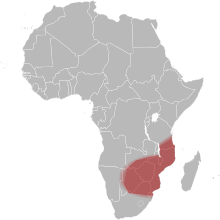Mozambique spitting cobra
| Naja mossambica | |
|---|---|
.jpg) | |
| Not evaluated (IUCN 3.1) | |
| Scientific classification | |
| Kingdom: | Animalia |
| Phylum: | Chordata |
| Class: | Reptilia |
| Order: | Squamata |
| Suborder: | Serpentes |
| Family: | Elapidae |
| Genus: | Naja |
| Species: | N. mossambica |
| Binomial name | |
| Naja mossambica Peters, 1854[1] | |
 | |
| Mozambique spitting cobra distribution | |
| Synonyms | |
|
Naja nigricollis mossambica Peters, 1854 | |
The Mozambique spitting cobra (Naja mossambica) is a species of spitting cobra native to Africa.
Description
In color the snake is slate to blue, olive or tawny black above, with some or all scales black-edging. Below, salmon pink to purple yellowish, with black bars across the neck and ventrals speckled or edged with brown or black; young specimens sometimes have pink or yellow bars on the throat.[2][3]
The average length of adults is between 90 cm - 105 cm (3-3½ feet), but largest specimen actually measured was a male 154 cm (5 feet) long. (Durban, Kwa-Zulu Natal, South Africa]).[3]
Distribution
This species is the most common cobra of the savanna regions of the tropical and subtropical Africa. The distribution includes Natal, as far south as Durban, Mpumalanga Province Lowveld region, south-eastern Tanzania and Pemba Island and west to southern Angola and northern Namibia. Younger specimens are much more frequently encountered in the open at daytime. Unlike the Egyptian Cobra, this species prefers localities near water, to which it will readily take when disturbed.[3]
Toxicology
It is considered one of the most dangerous snakes in Africa. Its venom is about as toxic as the American Mojave rattlesnake, considered the world's most venomous rattlesnake. Like the Rinkhals, it can spit its venom. Its bite causes severe local tissue destruction (similar to that of the puff adder). Venom to the eyes can also cause impaired vision or blindness.[3] The Venom of this specie contains postsynaptic neurotoxin and cytotoxin. There have been only a few fatalities resulting from bites of this specie but survivors are mostly disfigured.[4]
Diet
This cobra's diet mainly consists of amphibians, other snakes, birds, eggs, small mammals, and even insects occasionally.[3]
Habits
This snake is nervous and highly strung. When confronted at close quarters this snake can rear up to as much as two-thirds of its length, spread its long narrow hood and will readily "spit" in defense, usually from a reared-up position. By doing this the venom can be ejected at a distance of 2–3 metres (6½-10 feet), with remarkable accuracy. The spitting cobra does bite depending on its environment and the situation it is in, and also shares the same habit with the Rinkhals of feigning death to avoid further molestation.[2]
When in a confined area like a tube the reptile will bite instead of spit.
Reproduction
The eggs average 10 to 22 in number, hatchlings measure 230-250mm.
References
- ↑ "Naja mossambica". Integrated Taxonomic Information System. Retrieved 11 January 2014.
- 1 2 Carruthers, Vincent (2005). The Wildlife of Southern Africa: A Field Guide to the Animals and Plants of the Region?. Struik. p. 100. ISBN 978-1-86872-451-2.
- 1 2 3 4 5 Branch, Bill (1998). Field Guide to the Snakes and Other Reptiles of Southern Africa. Ralph Curtis Publishing. p. 109. ISBN 9780883590423.
- ↑ Venomous Snakes of the world by Mark O'Shea, Page number 72